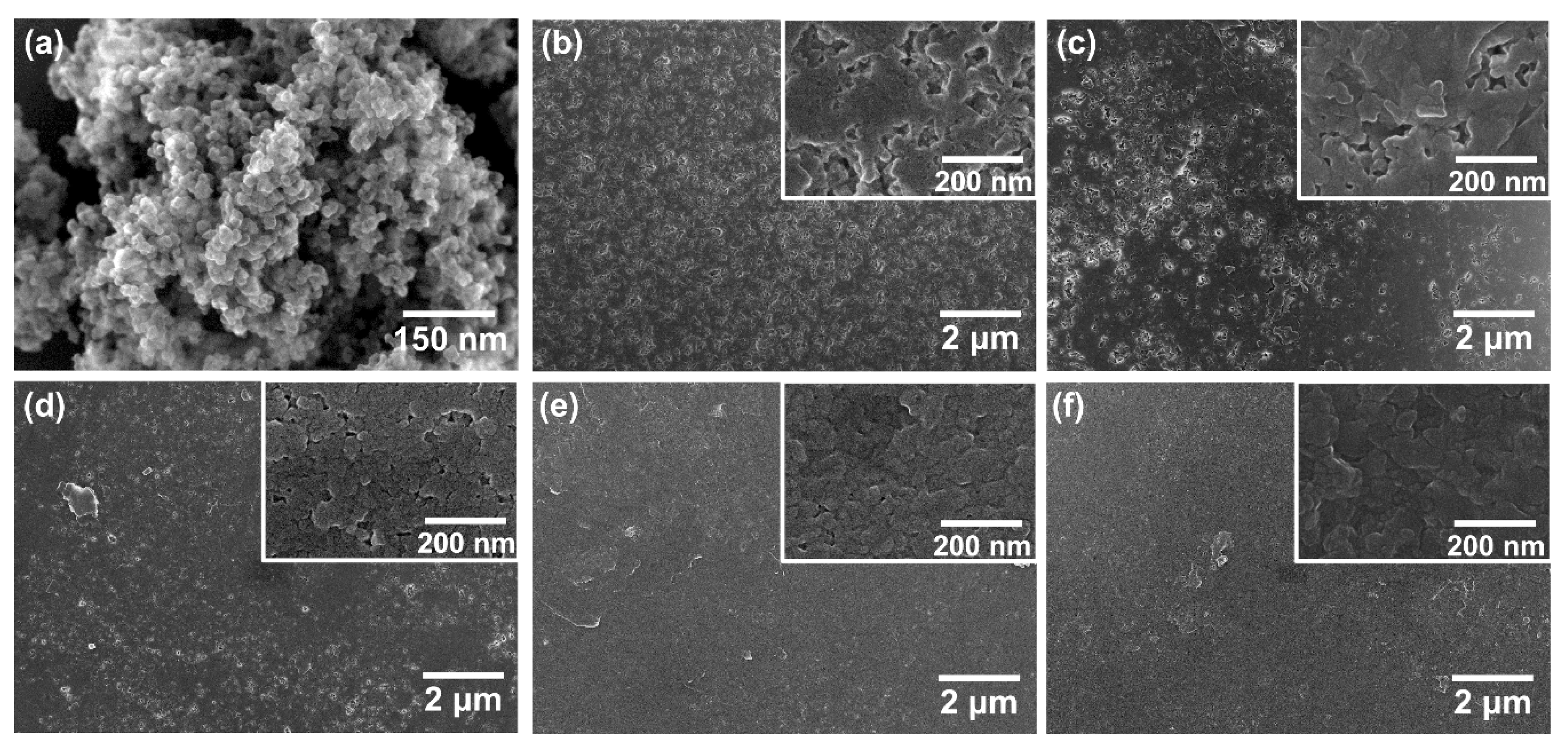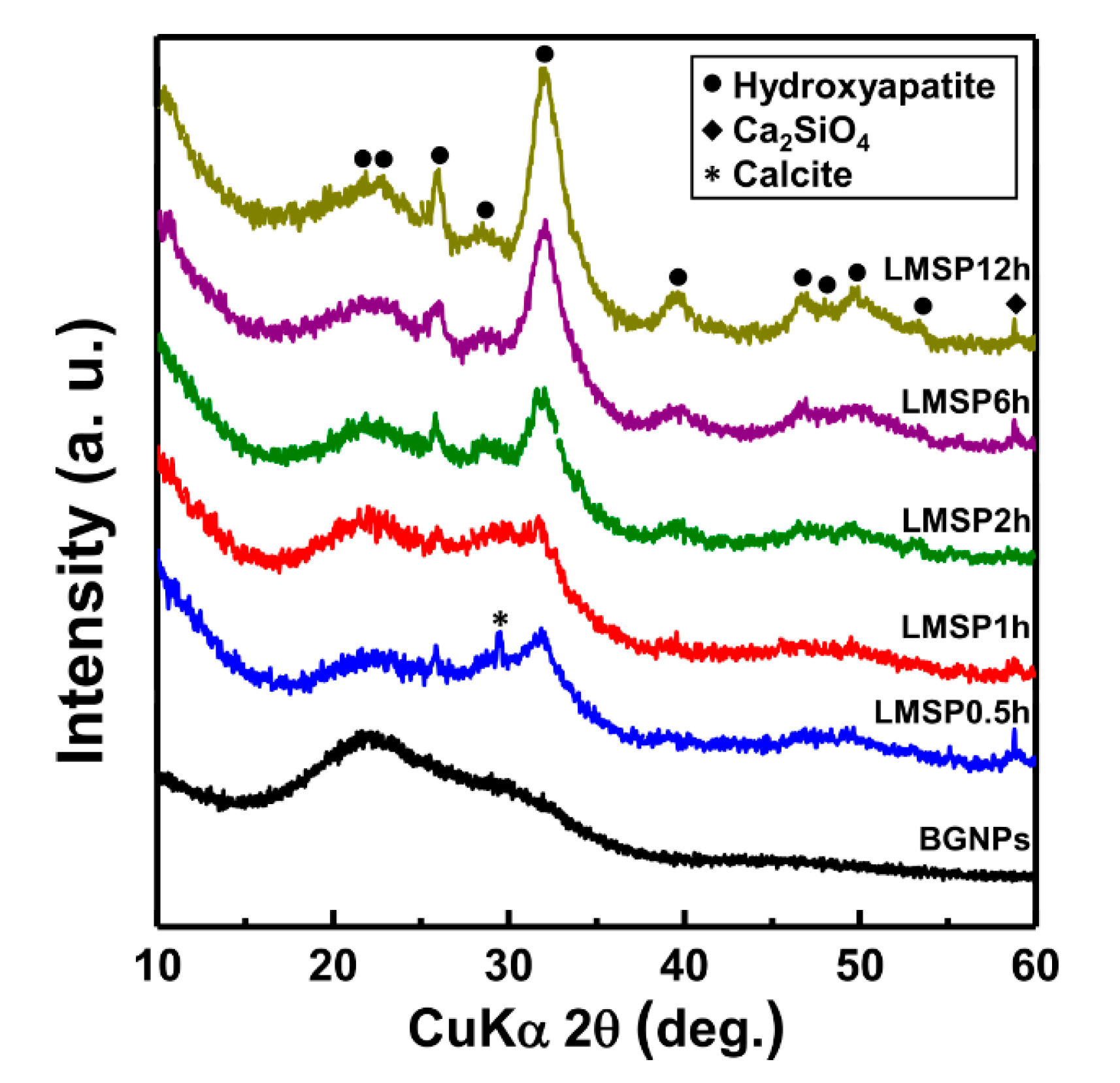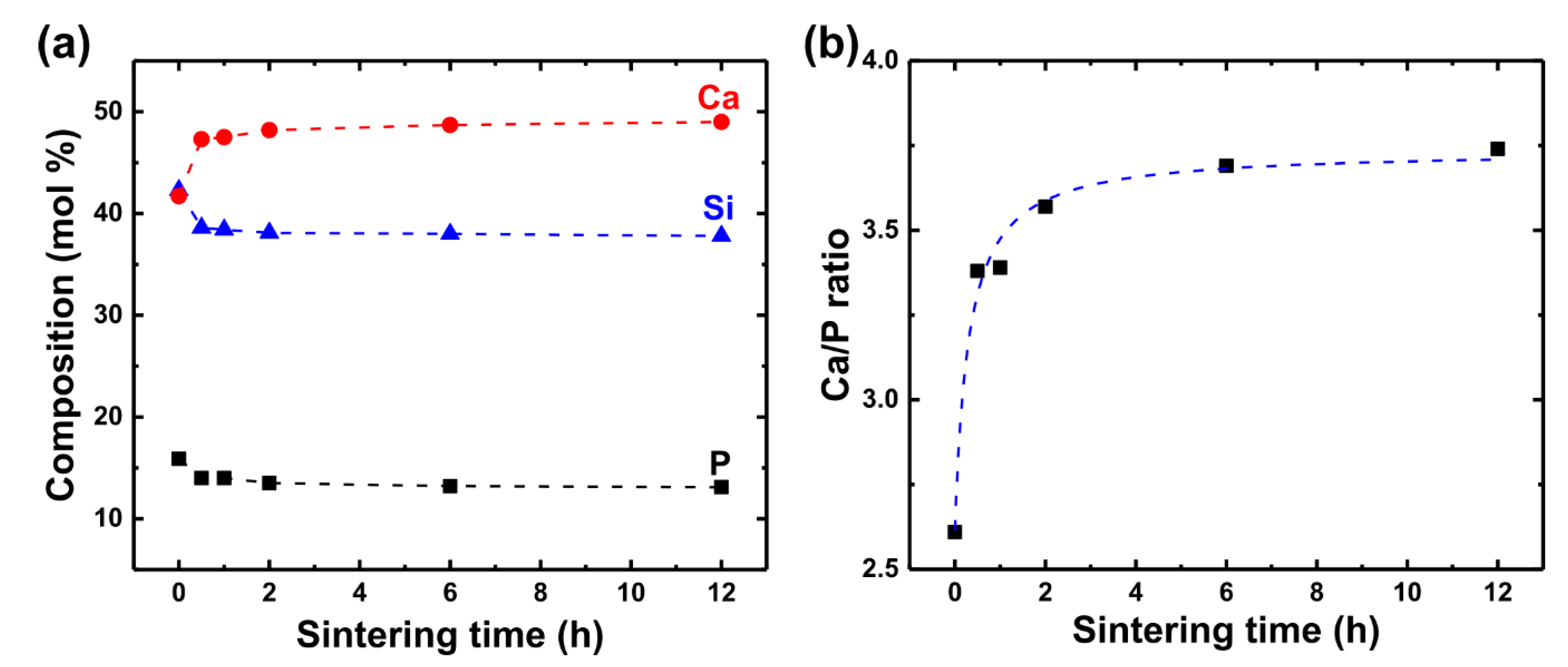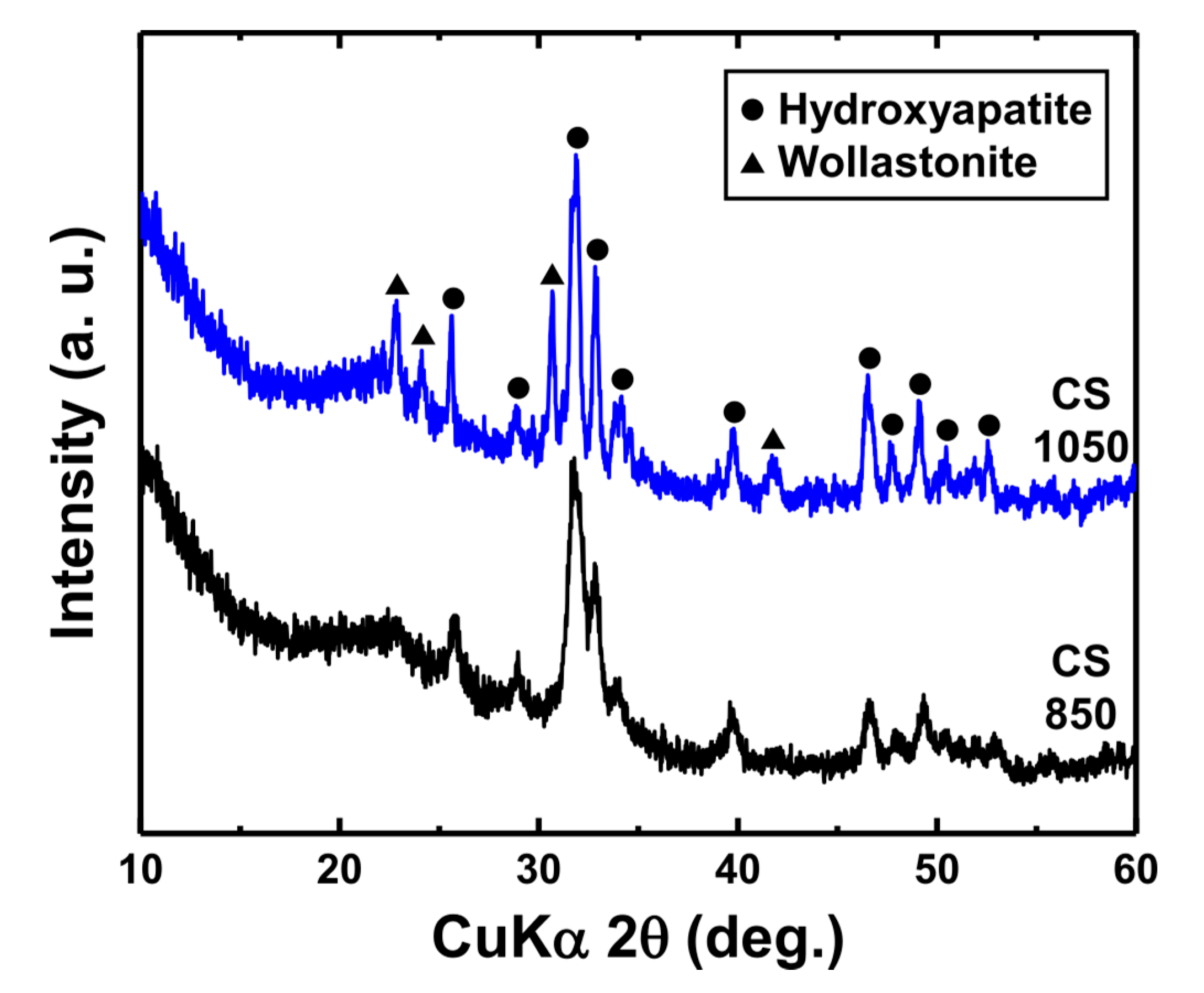Crystallization Behavior of the Low-Temperature Mineralization Sintering Process for Glass Nanoparticles
Abstract
:1. Introduction
2. Materials and Methods
2.1. Preparation of BGNPs Based on SiO2-CaO-P2O5
2.2. LMSP and Conventional Sintering of BGNPs
2.3. Characterization
3. Results and Discussion
3.1. Densification and Crystallization Behavior During LMSP
3.2. Chemical Conversion During LMSP
3.3. Relationship Between Compositional Changes and the Densification Rate
3.4. Comparison of Vickers Hardness between LMSP and CS Samples
4. Conclusions
Author Contributions
Funding
Acknowledgments
Conflicts of Interest
Appendix A
References
- Rahaman, M.N. Sintering of Ceramics, 1st ed.; CRC Press: Boca Raton, FL, USA, 2007. [Google Scholar]
- Guo, H.; Baker, A.; Guo, J.; Randall, C.A. Protocol for Ultralow-Temperature Ceramic Sintering: An Integration of Nanotechnology and the Cold Sintering Process. ACS Nano 2016, 10, 10606–10614. [Google Scholar] [CrossRef] [PubMed]
- Heidari, F.; Razavi, M.; Ghaedi, M.; Forooghi, M.; Tahriri, M.; Tayebi, L. Investigation of mechanical properties of natural hydroxyapatite samples prepared by cold isostatic pressing method. J. Alloys Compd. 2017, 693, 1150–1156. [Google Scholar] [CrossRef]
- Marion, J.E.; Hsueh, C.H.; Evans, A.G. Liquid-Phase Sintering of Ceramics. J. Am. Ceram. Soc. 1987, 70, 708–713. [Google Scholar] [CrossRef]
- Wan, Y.; Cui, T.; Li, W.; Li, C.; Xiao, J.; Zhu, Y.; Ji, D.; Xiong, G.; Luo, H. Mechanical and biological properties of bioglass/magnesium composites prepared via microwave sintering route. Mater. Des. 2016, 99, 521–527. [Google Scholar] [CrossRef]
- Sevgi Canarslan, Ö.; Rosa, R.; Köroğlu, L.; Ayas, E.; Kara, A.; Veronesi, P. Microwave Sintering of SiAlON Ceramics with TiN Addition. Materials 2019, 12, 1345. [Google Scholar] [CrossRef] [Green Version]
- Gao, L.; Hong, J.S.; Miyamoto, H.; Torre, S.D.D.L. Bending strength and microstructure of Al2O3 ceramics densified by spark plasma sintering. J. Eur. Ceram. Soc. 2000, 20, 2149–2152. [Google Scholar] [CrossRef]
- Grasso, S.; Chinnam, R.K.; Porwal, H.; Boccaccini, A.R.; Reece, M.J. Low temperature spark plasma sintering of 45S5 Bioglass®. J. Non. Cryst. Solids 2013, 362, 25–29. [Google Scholar] [CrossRef]
- Yu, M.; Grasso, S.; Mckinnon, R.; Saunders, T.; Reece, M.J. Review of flash sintering: Materials, mechanisms and modelling. Adv. Appl. Ceram. 2017, 116, 24–60. [Google Scholar] [CrossRef] [Green Version]
- Bajpai, I.; Han, Y.H.; Yun, J.; Francis, J.; Kim, S.; Raj, R. Preliminary investigation of hydroxyapatite microstructures prepared by flash sintering. Adv. Appl. Ceram. 2016, 115, 276–281. [Google Scholar] [CrossRef]
- Sibi, N.; Rajan, A.; Subodh, G. Garnet mineral-based composites through cold sintering process: Microstructure and dielectric properties. J. Eur. Ceram. Soc. 2020, 40, 371–375. [Google Scholar] [CrossRef]
- Gouda, G.R.; Roy, D.M. Characterization of Hot-Pressed Cement Pastes. J. Am. Ceram. Soc. 1976, 59, 412–414. [Google Scholar] [CrossRef]
- Yamasaki, N.; Yanagisawa, K.; Nishioka, M.; Kanahara, S. A hydrothermal hot-pressing method: Apparatus and application. J. Mater. Sci. Lett. 1986, 5, 355–356. [Google Scholar] [CrossRef]
- Guo, H.; Guo, J.; Baker, A.; Randall, C.A. Hydrothermal-Assisted Cold Sintering Process: A New Guidance for Low-Temperature Ceramic Sintering. ACS Appl. Mater. Interfaces 2016, 8, 20909–20915. [Google Scholar] [CrossRef] [PubMed]
- Guo, H.; Baker, A.; Guo, J.; Randall, C.A. Cold Sintering Process: A Novel Technique for Low-Temperature Ceramic Processing of Ferroelectrics. J. Am. Ceram. Soc. 2016, 99, 3489–3507. [Google Scholar] [CrossRef]
- Guo, J.; Baker, A.L.; Guo, H.; Lanagan, M.; Randall, C.A. Cold sintering process: A new era for ceramic packaging and microwave device development. J. Am. Ceram. Soc. 2017, 100, 669–677. [Google Scholar] [CrossRef]
- Maria, J.P.; Kang, X.; Floyd, R.D.; Dickey, E.C.; Guo, H.; Guo, J.; Baker, A.; Funihashi, S.; Randall, C.A. Cold sintering: Current status and prospects. J. Mater. Res. 2017, 32, 3205–3218. [Google Scholar] [CrossRef] [Green Version]
- Xu, C.; Su, P.; Chen, X.; Meng, Y.; Yu, W.; Xiang, A.P.; Wang, Y. Biocompatibility and osteogenesis of biomimetic Bioglass-Collagen-Phosphatidylserine composite scaffolds for bone tissue engineering. Biomaterials 2011, 32, 1051–1058. [Google Scholar] [CrossRef]
- Vargas, G.E.; Mesones, R.V.; Bretcanu, O.; López, J.M.P.; Boccaccini, A.R.; Gorustovich, A. Biocompatibility and bone mineralization potential of 45S5 Bioglass®-derived glass–ceramic scaffolds in chick embryos. Acta Biomater. 2009, 5, 374–380. [Google Scholar] [CrossRef]
- Fernandes, H.R.; Gaddam, A.; Rebelo, A.; Brazete, D.; Stan, G.E.; Ferreira, J.M.F. Bioactive Glasses and Glass-Ceramics for Healthcare Applications in Bone Regeneration and Tissue Engineering. Materials 2018, 11, 2530. [Google Scholar] [CrossRef] [Green Version]
- Hench, L.L. Bioceramics. J. Am. Ceram. Soc. 1998, 81, 1705–1728. [Google Scholar] [CrossRef]
- Gomez-Vega, J.M.; Saiz, E.; Tomsia, A.P.; Marshall, G.W.; Marshall, S.J. Bioactive glass coatings with hydroxyapatite and Bioglass® particles on Ti-based implants. 1. Processing. Biomaterials 2000, 21, 105–111. [Google Scholar] [CrossRef]
- Verné, E.; Fernández Vallés, C.; Vitale Brovarone, C.; Spriano, S.; Moisescu, C. Double-layer glass-ceramic coatings on Ti6Al4V for dental implants. J. Eur. Ceram. Soc. 2004, 24, 2699–2705. [Google Scholar] [CrossRef]
- Schrooten, J.; Helsen, J.A. Adhesion of bioactive glass coating to Ti6Al4V oral implant. Biomaterials 2000, 21, 1461–1469. [Google Scholar] [CrossRef]
- Sear, R.P. Nucleation: Theory and applications to protein solutions and colloidal suspensions. J. Phys. Condens. Matter 2007, 19, 033101. [Google Scholar] [CrossRef]
- Hong, Z.; Reis, R.L.; Mano, J.F. Preparation and in vitro characterization of novel bioactive glass ceramic nanoparticles. J. Biomed. Mater. Res. A 2009, 88A, 304–313. [Google Scholar] [CrossRef] [PubMed] [Green Version]
- Luz, G.M.; Mano, J.F. Nanoengineering of bioactive glasses: Hollow and dense nanospheres. J. Nanoparticle Res. 2013, 15, 1–11. [Google Scholar] [CrossRef]
- De Oliveira, A.A.R.; de Carvalho, B.B.; Sander Mansur, H.; de Magalhães Pereira, M. Synthesis and characterization of bioactive glass particles using an ultrasound-assisted sol-gel process: Engineering the morphology and size of sonogels via a poly(ethylene glycol) dispersing agent. Mater. Lett. 2014, 133, 44–48. [Google Scholar] [CrossRef]
- Kokubo, T.; Kushitani, H.; Sakka, S.; Kitsugi, T.; Yamamuro, T. Solutions able to reproduce in vivo surface-structure changes in bioactive glass-ceramic A-W. J. Biomed. Mater. Res. 1990, 24, 721–734. [Google Scholar] [CrossRef]
- Bellucci, D.; Desogus, L.; Montinaro, S.; Orrù, R.; Cao, G.; Cannillo, V. Innovative hydroxyapatite/bioactive glass composites processed by spark plasma sintering for bone tissue repair. J. Eur. Ceram. Soc. 2017, 37, 1723–1733. [Google Scholar] [CrossRef] [Green Version]
- Mozafari, M.; Moztarzadeh, F.; Tahriri, M. Investigation of the physico-chemical reactivity of a mesoporous bioactive SiO2-CaO-P2O5 glass in simulated body fluid. J. Non. Cryst. Solids 2010, 356, 1470–1478. [Google Scholar] [CrossRef]
- Chen, W.; Long, T.; Guo, Y.J.; Zhu, Z.A.; Guo, Y.P. Hydrothermal synthesis of hydroxyapatite coatings with oriented nanorod arrays. RSC Adv. 2014, 4, 185–191. [Google Scholar] [CrossRef]
- Dziadek, M.; Zagrajczuk, B.; Jelen, P.; Olejniczak, Z.; Cholewa-Kowalska, K. Structural variations of bioactive glasses obtained by different synthesis routes. Ceram. Int. 2016, 42, 14700–14709. [Google Scholar] [CrossRef]
- Tarasevich, B.J.; Chusuei, C.C.; Allara, D.L. Nucleation and Growth of Calcium Phosphate from Physiological Solutions onto Self-Assembled Templates by a Solution-Formed Nucleus Mechanism. J. Phys. Chem. B 2003, 107, 10367–10377. [Google Scholar] [CrossRef]
- Mami, M.; Lucas-Girot, A.; Oudadesse, H.; Dorbez-Sridi, R.; Mezahi, F.; Dietrich, E. Investigation of the surface reactivity of a sol-gel derived glass in the ternary system SiO2-CaO-P2O5. Appl. Surf. Sci. 2008, 254, 7386–7393. [Google Scholar] [CrossRef]
- Vulpoi, A.; Baia, L.; Simon, S.; Simon, V. Silver effect on the structure of SiO2-CaO-P2O5 ternary system. Mater. Sci. Eng. C 2012, 32, 178–183. [Google Scholar] [CrossRef]
- Notingher, I.; Jones, J.R.; Verrier, S.; Bisson, I.; Embanga, P.; Edwards, P.; Polak, J.M.; Hench, L.L. Application of FTIR and Raman spectroscopy to characterisation of bioactive materials and living cells. Spectroscopy 2003, 17, 275–288. [Google Scholar] [CrossRef] [Green Version]
- Kokubo, T.; Ito, S.; Shigematsu, M.; Sakka, S.; Yamamuro, T. Mechanical properties of a new type of apatite-containing glass-ceramic for prosthetic application. J. Mater. Sci. 1985, 20, 2001–2004. [Google Scholar] [CrossRef]
- Sun, H.; He, S.; Wu, P.; Gao, C.; Feng, P.; Xiao, T.; Deng, Y.; Shuai, C. A Novel MgO-CaO-SiO2 System for Fabricating Bone Scaffolds with Improved Overall Performance. Materials 2016, 9, 287. [Google Scholar] [CrossRef] [Green Version]
- Shumkova, V.V.; Pogrebenkov, V.M.; Karlov, A.V.; Kozik, V.V.; Vereshchagin, V.I. Hydroxyapatite-wollastonite bioceramics. Glas. Ceram. 2000, 57, 350–353. [Google Scholar] [CrossRef]









| Samples | SiO2 (wt%) | CaO (wt%) | P2O5 (wt%) | Impurity (wt%) | Theoretical Density (g/cm3) |
|---|---|---|---|---|---|
| LMSP0.5h | 45.8 | 37.3 | 16.8 | 0.1 | 2.846 |
| LMSP1h | 45.6 | 37.6 | 16.7 | 0.1 | 2.848 |
| LMSP2h | 45.2 | 38.3 | 16.4 | 0.1 | 2.854 |
| LMSP6h | 45.1 | 38.8 | 15.9 | 0.2 | 2.856 |
| LMSP12h | 45.1 | 39.0 | 15.8 | 0.1 | 2.861 |
| CS850 | 45.4 | 38.2 | 16.1 | 0.3 | 2.849 |
| CS1050 | 45.0 | 38.4 | 16.4 | 0.2 | 2.852 |
© 2020 by the authors. Licensee MDPI, Basel, Switzerland. This article is an open access article distributed under the terms and conditions of the Creative Commons Attribution (CC BY) license (http://creativecommons.org/licenses/by/4.0/).
Share and Cite
Seo, Y.; Goto, T.; Cho, S.; Sekino, T. Crystallization Behavior of the Low-Temperature Mineralization Sintering Process for Glass Nanoparticles. Materials 2020, 13, 3281. https://doi.org/10.3390/ma13153281
Seo Y, Goto T, Cho S, Sekino T. Crystallization Behavior of the Low-Temperature Mineralization Sintering Process for Glass Nanoparticles. Materials. 2020; 13(15):3281. https://doi.org/10.3390/ma13153281
Chicago/Turabian StyleSeo, Yeongjun, Tomoyo Goto, Sunghun Cho, and Tohru Sekino. 2020. "Crystallization Behavior of the Low-Temperature Mineralization Sintering Process for Glass Nanoparticles" Materials 13, no. 15: 3281. https://doi.org/10.3390/ma13153281






